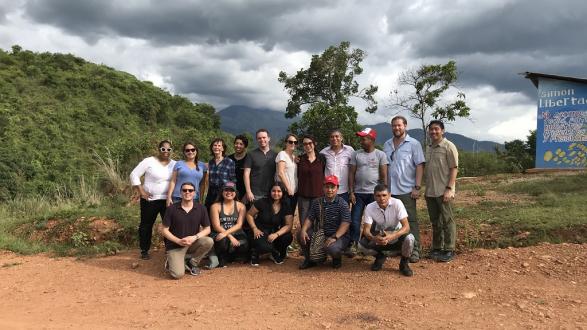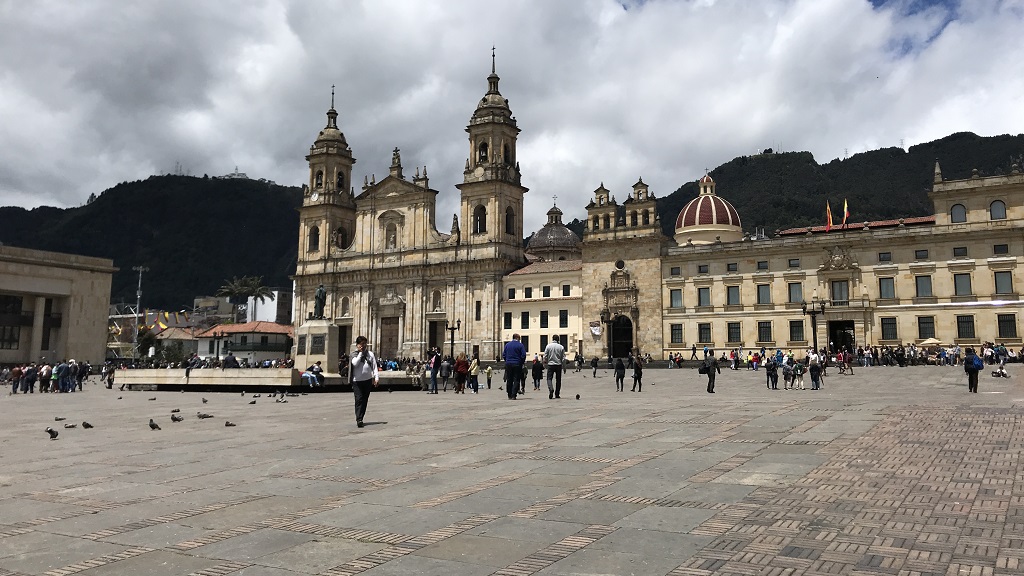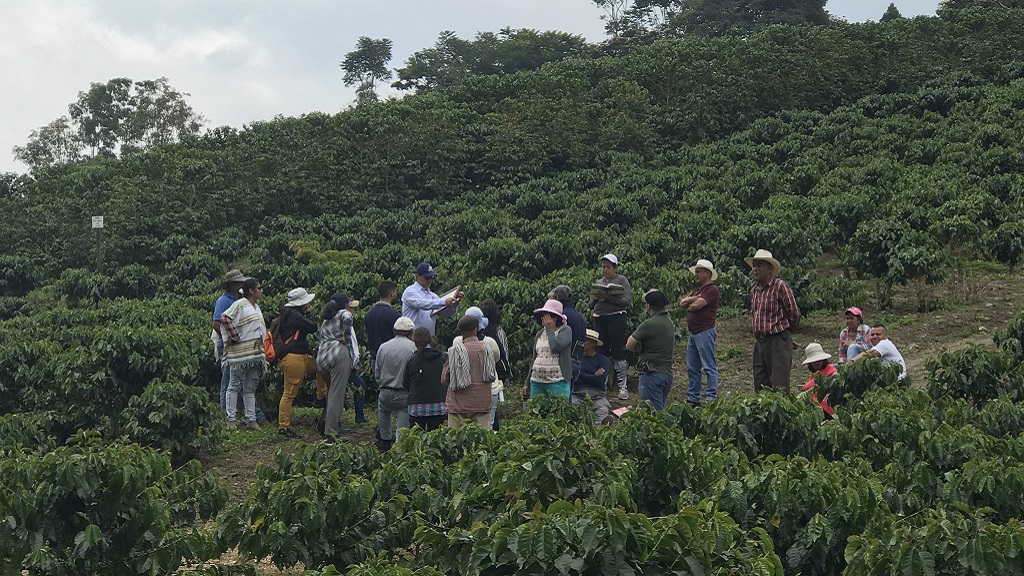A Pacific Council delegation composed largely of Emerging Leaders from its community recently traveled to Colombia to explore the landscape of the 2016 peace process negotiated between the Revolutionary Armed Forces (FARC) and the Colombian government.
Delegates met with senior government officials, business and NGO sector leaders, and former FARC combatants. Topics included the peace process, Venezuela, economic development, and women’s empowerment.
Peace Deal: Background
A peace deal was negotiated between FARC leadership and the Juan Manuel Santos administration in November 2016, ending over 50 years of conflict. Since the election of Ivan Duque Marquez in August 2018, the peace deal has been challenged by the conservative politics of his party and a division in public confidence. The conflict spanned over five decades, spawned egregious violence, resulted in the disappearance of thousands, and left some 260,000 dead and millions displaced. The prospect of ex-convicts walking free without justice served stands at the heart of the divisiveness of the peace accord.
Politics
Colombia has long stood apart from other Latin American countries. It has historically elected conservative administrations and governed under strong macro-economic policy that built a robust middle class in its urban centers. This, in stark contrast to the populism and military dictatorships in the late 20th century in Argentina, Brazil, Chile, and the recent socialist regimes in Venezuela and Bolivia, has made for a regionally competitive country whose GDP stands with Argentina, Mexico, and Brazil.
For a long time, populist left wing politics was missing from the political forum as they were associated with the FARC, and left wing politicians were targeted by right wing paramilitary groups. Since the peace negotiation was enshrined in Colombia’s constitution and FARC was established as a legitimate political party, populist politics has taken a seat at the table as a legitimate ideology, thus commencing what some political leaders deem the rise of a Colombia that is a more “normal” Latin American country.
This new dynamic not only challenges the dominating conservative agenda and economic policy but it also places the onus on the current administration to establish a presence of state in the large swaths of ungoverned territory across the country that have historically been ruled by FARC, paramilitaries, and other extremist groups.
Several speakers reported that the federal government had struggled to build infrastructure and expand economic opportunity in reclaimed areas following the peace accord.
Duque’s election platform was predicated on disputing fundamental components of the deal, particularly associated with a regulatory body called the Special Jurisdiction for Peace (JEP), which was established under the agreement to try former combatants accused of atrocities. Under the JEP, former combatants would receive alternative sentences to prison time if they confess their crimes, compensate victims, and pledge to never commit violence again.
The UN and several European countries who financially support the accord condemned Duque’s challenges and the deal ultimately withstood such grievances as the Colombian Supreme Court passed legislation to shield the accord and demanded that the negotiations be complied with as stated in the constitution.
Economic Development
Several speakers the delegation met with described the country’s relatively conservative approach to fiscal policy, particularly compared to its regional neighbors. The country has experienced an economic turnaround over the past decade as its security situation has improved, with the GDP almost doubling since 1990. The World Bank projects that Colombia will see 3.3 percent economic growth in 2019 and 3.6 percent growth in 2020.
At the same time, Colombia’s economic development continues to be inequitably distributed across the country with outer regions effectively shut out of Colombia’s economy. While the scale of the informal economy has declined in recent years, 62.3 percent of workers were not contributing to social security as of 2017. Furthermore, 46.8 percent of workers are in vulnerable employment, the second highest in the region (behind Peru). Several speakers reported that the federal government had struggled to build infrastructure and expand economic opportunity in reclaimed areas following the peace accord.
Delegates had an opportunity to visit a FARC reintegration camp, which provides a safe haven for former combatants to socialize themselves into society during the transition from war to peace and to learn various trades and develop entrepreneurial projects.
Duque administration officials emphasized their focus on entrepreneurship, education, and environmental sustainability. They also highlighted growing foreign investment into the country as a driver of growth. In particular, they highlighted their strategy to develop the cultural economy (which they called the “Orange Economy”) through investment in the arts and software development.
Peace Accord Infrastructure and Timeline
In 2016, the government and FARC signed the peace deal. In 2017, FARC disarmed and surrendered their weapons to the UN. This process demobilized 13,000 combatants and most recently another 11,000. As part of the reintegration process, a bastion of the peace deal that provides a gateway for former combatants to reintegrate into society, the government along with funding from other countries established Espacios Territoriales de Capacitacion y Reincorporacion (ETCRs), which are essentially reintegration camps. These camps provide a safe haven for former combatants to socialize themselves into society during the transition from war to peace and to learn various trades and develop entrepreneurial projects.
Delegates had an opportunity to visit one such reintegration camp called Tierra Grata where the primary enterprise was administering eco tours. Included in Tierra Grata is a full-size replication of a typical FARC camp complete with camouflaged sleeping quarters, a classroom space where FARC leaders would expound on Marxist philosophy, and a kitchen with something colloquially termed a Vietnamese or Cuban oven—one that is designed to keep smoke from giving away their position. This particular reintegration camp also allows tourists to stay the night either in the guerilla camp or the government issued pre-fabricated housing decorated with murals that depict the conflict throughout its history.
ETCRs also focus on growing staple food crops instead of coca plants—another core tenet of the deal. Having served a critical function in the Colombian cocaine trade, FARC farmers had to exchange cultivation of coca plants for plantains, coffee, and other staple items.
The majority of the former FARC combatants are each doing their part to hold up the accord. The world is watching in the hopes that the over 50-year conflict has finally come to an end.
Shortly before our delegation arrived, a major FARC commander and key figure in the peace negotiations, Seuxis Pausias Hernández Solarte, whose fighter name is Jesus Santrich, was caught conspiring to traffic 10 tons of cocaine after the peace deal was negotiated. He then fled the country to escape justice and in his wake left behind a stained accord and a demoralized public confidence in the peace deal.
Further, shortly after the delegation left the country, FARC’s top peace deal negotiator, Luciana Marín, whose fighter name is Iván Márquez, made a call to re-arm in confluence with other former guerilla leaders accusing the government of betraying the accord. The new FARC political party, the Common Alternative Revolutionary Force, issued a statement rejecting the return to arms.
This call to arms struck a blow to an already tenuous peace process instilling fear in the Colombian populace that the accord would unravel. While a small group of dissidents have allegedly joined the leaders, Duque’s administration and the majority of the former FARC combatants are each doing their part to hold up the accord. The world is watching in the hopes that the over 50-year conflict has finally come to an end.
Venezuela
The ongoing crisis in Venezuela similarly hung over many of our conversations in Bogotá. As Nicolás Maduro strives to maintain his grip on power, the humanitarian situation in Venezuela continues to unravel, with essential goods becoming scarce and inflation skyrocketing. This has led to an enormous outflow of migrants, which the Organization of American States projects will surpass the number who have fled Syria sometime next year.
Colombia is now home to the largest share of that displaced population, more than 1.4 million, costing the government about 0.5 percent of its GDP to provide services to the new arrivals. Subsequently, Colombia’s foreign minister has projected that there could be up to 4 million Venezuelan migrants living in Colombia by 2021, with an estimated cost of roughly $9 billion. Nevertheless, many speakers remarked on how little public discontent the crisis has caused to date.
Colombia has largely welcomed these migrants and made efforts to provide them support. Just before we arrived in Bogotá, the Colombian government announced it would be extending citizenship to more than 24,000 undocumented children who had been born to Venezuelan refugees in the country, giving them access to health care and education resources. Almost everyone who spoke gave the same reason for this response: not long ago, the flood of refugees flowed in the opposite direction.
Colombia currently has the world’s largest internally displaced population and it continues to struggle to provide services in large swaths of the country. Those challenges will only grow with time.
For decades, the government, guerillas, and drug cartels clashed, resulting in escalating violence across the country. At the time, Venezuela was Colombia’s relatively affluent and stable neighbor and Colombians were facing large-scale displacement, both internally and to other countries in the region. Millions of Colombians were said to have migrated to Venezuela over the course of the decades-long conflict and speakers described a bond between the two countries and a sense of obligation. Today, a substantial number of the migrants crossing the border are reportedly Colombians, previously displaced by violence, returning to their home country.
This history of reciprocation led many we met with to describe a civic obligation to welcome migrants fleeing their homes, though questions remain over how long that sentiment will last. Colombia currently has the world’s largest internally displaced population and it continues to struggle to provide services in large swaths of the country. Those challenges will only grow with time.
Delegate Takeaways
Matthew Schumacher
The trip was an outstanding look into a complicated but functional political atmosphere where the dialogue is far more economic and rational (technocratic) but also more functional than current U.S. dialogue. Given the representation of Colombia as a third world country [in mainstream media], the elected representatives we met and their global and academic insights far exceeded my expectations and the bulk of current U.S. political dialogue.
I was very surprised at the marginalization of ideology as a factor in the reintegration of FARC, and was also surprised by how marginal an issue it appears to be. In large part, I got the sincere sense Colombia would much prefer the interest and attention of other nations, particularly the United States, for issues other than drug trafficking and the peace process, neither of which appear particularly central to the average concerns of more metropolitan Colombians. It seems the United States could put more emphasis on issues of greater concern to Colombians, which tend to be more economic and developmental in nature.
Finally, I was impressed at the slow, conservative plans for economic growth over many years (thus avoiding major recessions or bubbles) as well as the assertions by economists that the 1.5 million Venezuelan refugees are more likely to be an economic boon in the long-term, rather than a liability to fear.
Andrew Christopher
When most Americans think of Colombia, their minds immediately go to the days of narcos and violence. Mine did. But once you scratch beneath the surface you find a country and people much more complex, sophisticated, and proud than I would have ever imagined.
Upon our arrival in Bogotá, I was immediately struck by the juxtapositions of the city. Tall mountains surround a valley where the city sits, while the (relatively) flat valley floor has made the city a hub for bicycles, motorcycles, and pedestrians. Colonial architecture plays the backdrop for a city that is on the cutting edge of urban planning and transportation logistics (bus rapid transit, Colectivos, Uber, scooters, and more).
Our group gathered in a business sub-district on the north side of the city as our base of operations. Our trip began with briefings on the Colombian economy, politics, and international relations (centered on the United States and, for now, Venezuela, due to the crisis there). Immediately the themes of strong government, impartial judiciary, and innovative thinking (both in the public and private sectors) gave us vignettes into the social fabric that held the country together during its darkest periods. These themes carried throughout the trip as we met with local government leaders, academics, and representatives from the non-profit sector.
"Despite detractors and proponents of the peace agreement, it was clear to see that those who embraced the opportunity to become part of the newly thriving Colombia were immersed in the arrival of opportunity and hope for change."
Andrew Christopher
Despite the storied past of Colombia, we only heard about the country’s hope and plans for the future. Seeping with optimism and hope, the country’s Vice President Marta Lucia Ramirez told us how her government was closing the gap between the impoverished countryside and the wealthy city-dwellers by focusing on worker programs, building capacity and access, and broadening the educational opportunities to the most remote parts of the country.
Most impactful on our trip was the visit to the FARC reintegration camp in Valledupar, Colombia. The long hoped for peace between FARC and the Colombian government was playing out in real time. Despite detractors and proponents of the peace agreement, it was clear to see that those who embraced the opportunity to become part of the newly thriving Colombia were immersed in the arrival of opportunity and hope for change.
Departing from Medellín, Colombia, left us all wanting to come back and continue our exploration of this amazing country that too often gets grouped with the struggling states of Central and South America. I know I will be returning and continuing to explore the country’s rich cultural and human history.
_______________________
Thomas Zimmerman is the Director of Programs at the Pacific Council.
Ashley McKenzie is the Senior Officer, Delegations at the Pacific Council.
Learn more about Pacific Council delegations. Check out photos from this delegation on our Flickr page.
The views and opinions expressed here are those of the speakers and do not necessarily reflect the official policy or position of the Pacific Council.






